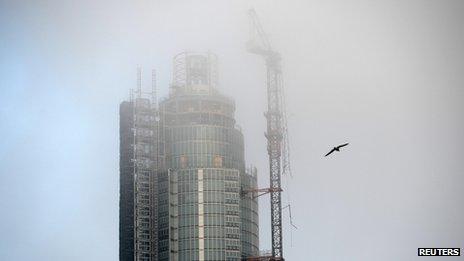London helicopter crash: Passenger 'had concerns about weather'
- Published
Eyewitness Paul Ferguson: Helicopter 'plunged straight to the ground'
A passenger due to be collected by a helicopter which crashed in central London had suggested the pilot delay taking off, it has been revealed.
Pilot Capt Pete Barnes and a pedestrian died when the helicopter hit a crane in Vauxhall on 16 January.
A report by the Air Accidents Investigation Branch, external shows the client had concerns about the weather and twice suggested take-off be delayed.
The pilot responded by saying he was already starting his engines.
The interim report into the crash also says evidence indicates the top of the crane on The Tower, St George Wharf, was obscured by cloud and details the final exchange between the pilot and the air traffic controller.
Weather discussion
Matthew Wood, 39, of Sutton, south London, was killed as he was walking to work.
The Met Office said at the time of the crash the area was prone to widespread low cloud, poor visibility and patches of freezing fog.
Mr Barnes, 50, was flying from Redhill Aerodrome in Surrey to Elstree when the helicopter crashed into the crane and the wreckage fell into Wandsworth Road.
His client, fashion businessman Richard Caring, who was due to be flown to the north of England with another passenger, called him at 07:18 GMT to discuss the weather.
Mr Barnes told him he thought the weather might clear earlier than forecast.
At 07:31 Mr Caring called again and said that having seen how "poor" conditions were on his way to Elstree he suggested the pilot not take off.
After arriving at Elstree at 07:46 and finding he could not land, the pilot was going to turn back to Redhill but decided to make a diversion to Battersea Heliport.
He was held hovering between Vauxhall and Westminster bridges while the controller checked if it was clear to land at Battersea.
After being told the heliport was open, he replied: "Lovely. Thanks."
Moments before hitting the crane, his final words were: "Thanks a lot."
Mr Barnes, who lived near Reading in Berkshire, had flown for Redhill firm Rotormotion for 15 years and colleagues described him as "highly skilled".
Mr Caring said he was a "very dear friend" and a "very accomplished pilot".
Other details in the Air Accidents Investigation Branch (AAIB) report include:
Another pilot who was aware of the journey planned by Mr Barnes, sent him a message which read: "Give me a call as I have checked weather and freezing fog around at the moment."
Calculations suggest the collision happened at 682 ft (207m) above ground level.
The total height from the ground to the top of the crane's jib was 719 ft (219m).
About 500kg of jet fuel was on board at the time.
Witness and CCTV evidence indicate the top of the crane and the top of the building to which it was attached were obscured by cloud at the time of impact.
The fuel ignited at the point of impact with the ground.
The main rotor head, gearbox and a section of one of the four rotor blades from the helicopter landed in the loading bay of the nearby New Covent Garden Flower Market where it hit a delivery van.
The AAIB was notified of the crash at 08:20.
'Extremely hard'
In the report, it said it would "conduct a detailed inspection of recovered wreckage and helicopter maintenance documents, and an analysis of weather conditions".
It added: "The investigation will also examine the conduct of this flight, regulation of flights over London, planning guidance and regulations relevant to development around aerodromes, and the lighting of obstacles."

Mist shrouds the damaged crane on The Tower on the day of the crash
Aviation expert David Learmont from Flight International magazine said the pilot faced a very difficult task in changing course to land at Battersea.
"It was extremely hard as he couldn't go up much because of Heathrow's approach, and he couldn't go down because of the high buildings.
"He wasn't doing a 180 degree turn for fun.
"He was carrying out a turn to the right and that is a demanding manoeuvre in conditions where visibility is limited.
"He also had to look everywhere at the same time; down where the Thames is as he was navigating by that to get to Battersea; sideways into the turn and he also had to turn his eyes downward to retune the radio to Battersea. He had a lot on his hands."
Mr Learmont said what the report did not say was what the visibility was like at the height Mr Barnes was flying.
He added that radar can be used by air traffic control to direct helicopters to avoid objects however that can involve a very big detour.
Mr Learmont said Mr Barnes was navigating visually so he either did not see the crane, or it could not be seen.

- Published22 January 2013